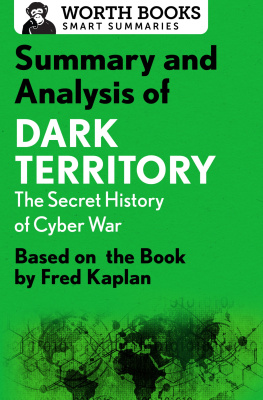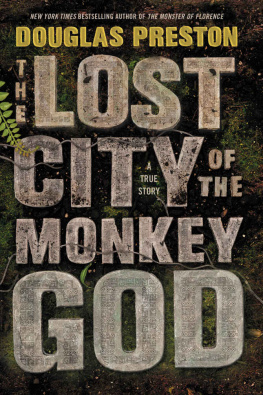Sign up for our newsletter to discover more ebooks worth reading.
EARLY BIRD BOOKS
FRESH EBOOK DEALS, DELIVERED DAILY
LOVE TO READ ?
LOVE GREAT SALES ?
GET FANTASTIC DEALS ON BESTSELLING EBOOKS DELIVERED TO YOUR INBOX EVERY DAY!
Summary and Analysis of
The Lost City of the Monkey God
A True Story
Based on the Book by Douglas Preston
The summary and analysis in this ebook are meant to complement your reading experience and bring you closer to a great work of nonfiction. This ebook is not intended as a substitute for the work that it summarizes and analyzes, and it is not authorized, approved, licensed, or endorsed by the works author or publisher. Worth Books makes no representations or warranties with respect to the accuracy or completeness of the contents of this ebook.
Contents
Context
The story of Ciudad Blanca (the White City), also known as the City of the Monkey God, has been a Central American legend for more than five centuries. Tales of a settlement buried deep in the worlds most inhospitable jungle have been circulating since the days of the earliest Europeans to arrive in the New World. The Spanish conquistadores heard this legendHernn Corts even wrote of it to King Charles V of Spainbut never found the city. It was said to be a cursed place.
The legends persisted into the 19th and 20th centuries, drawing adventurers, treasure hunters, and archaeologists to the La Mosquitia region of Honduras, which is perhaps the most dangerous place on earth. It is a land of dense jungle and forbidding mountains, and host to jaguars, disease-ridden insects, and the worlds most venomous snakes.
In spite of these dangers and difficulties, people continued to seek out Ciudad Blanca. Charlatans and hucksters even claimed to find it. The Lost City of the Monkey God tells the modern Indiana Jones story of a group of adventurers, filmmakers, and scientists who went deep into unexplored regions of Mosquitia and what they found there. It is the firsthand account, told by journalist and author Douglas Preston, of the search for what could be the greatest archaeological discovery of the 21st century.
Overview
The Lost City of the Monkey God tells the story of the search for ancient ruins deep in the jungles of Hondurasthe unexplored remnants of a lost civilization. The region of La Mosquitia is incredibly isolatedwalled by precipitous mountains, filled with thick jungle, and infested with deadly snakes, jaguars, and dangerous insects.
In the 1990s, cinematographer and adventurer Steve Elkins first heard legends of Ciudad Blanca, sometimes called the City of the Monkey God, and was inspired to investigate it. Through extensive research, he became convinced that the legends were true. When Elkins learned how difficult it was to penetrate Mosquitia, he was forced to abandon his search until the advent of high-tech laser sensing equipment called lidar, or Light Detection and Ranging. In 2012, he organized airborne lidar scans of several sites in Mosquitia, and the results were astonishing. The lidar identified evidence of extensive human habitation, including two cities and numerous smaller settlements. The entire region had been shaped by human handsan unidenified civilization that had emerged just as Mayan society fell into decline, buried by the overgrown jungle and lost to history.
In three years of effort, Elkins planned an expedition to study the sites scanner by lidar firsthand on the ground. His team included the author, Douglas Preston, as well as archaeologists and ex-military bush rangers who were brought in to protect everyone from the extreme dangers of the area. Unlike the Maya, the people of Mosquitia did not build cut-stone temples; they used wood. All organic matter, including bone, had been dissolved and absorbed by the jungle. In the early stages of exploration, the team found earthen foundations, plazas, canals, and terraces, along with a cache of carved stone artifacts and pottery. The teams explorations also revealed that these legendary settlements had been unvisited by humans for centuries.
Once Elkins and his team had verified the existence of ruins in Mosquitia, they wondered: where did those people go? The expeditions lead archaeologist, Dr. Chris Fisher, theorized that disease first brought by Christopher Columbuss expeditions and later the Spanish conquistadores wiped out 90 to 95% of the indigenous population of Central America. The cities of Mosquitia likely disappeared because there was no one left to live in them.
After the expedition ended, more than half of the team, including Preston, fell ill. The Mosquitia ruins were infested with a parasite, a strain of leishmania, transmitted by sand fly bites. Like malaria, the disease cannot be fully cured. Untreated, this form of leishmaniasis can eat away a victims face until very little remains of the sinus region; the Spanish called the affliction white leprosy. The deadly parasite imposed another barrier to further study of the ruins: Every researcher who visits the site would be exposed to severe parasitic infection.
Nevertheless, the discovery was a boon for Honduras and had tremendous cultural significancethe Lost City of the Monkey God had been found.
Summary
Chapter 1: The Gates of Hell
On February 15, 2015, a group of scientists, photographers, filmmakers, archaeologistsand one writergathered in a conference room at a hotel in Catacamas, Honduras, for a lecture. They were about to enter the Honduran jungle, an area called La Mosquitia, one of the most dangerous places on Earth. Their lecturer was a British ex-special forces soldier, and his job would be to protect them from a mind-boggling host of dangerous flora and fauna, and from the drug cartels that trafficked through the remote and lawless region. Mosquitiacovered by dense rainforest shrouding jagged mountains and valleys, towering waterfalls, and dangerous quickmudwas nearly impassable, and home to jaguars, sand flies that carried a parasite capable of rotting off ones face, bullet ants whose bite was more painful than a gunshot wound, and the fer-de-lance, the deadliest snake in the New World. Mosquitia was one of the last scientifically unexplored places on the planet.
This motley group was preparing to set out in search of a lost city, said to be Mayan or perhaps much older. Legends called it Ciudad Blanca, the White City, also referred to as the Lost City of the Monkey God.
Need to Know: Douglas Preston, the author, listened to their guides admonitions of safety measures and protocols, but he was pretty sure everything was going to be fine.
Chapter 2: I can tell you only that it is somewhere in the Americas.














